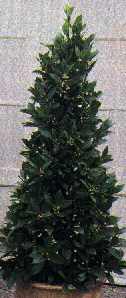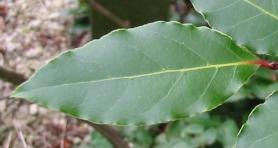Sweet Bay has been used medicinally for centuries and was commonly used by the ancient Greeks and Romans for various ailments as well as ritually for the famous garlands worn on their heads for festivities. The beautiful Bay Laurel was originally found in southern Europe on the shores of the Mediterranean. It is a much loved and highly fragrant tree which is most widely recognized for its resinous, fragrant leaves commonly used as an aromatic spice in cooking. It is an essential ingredient in the famed "Bouquet Garni' herb blend.
Sweet Bay has a long history of medicinal use although it is rarely used internally in modern herbalism. The leaves and fruits have strong narcotic properties and can be emetic in high doses. Bay was commonly used historically for respiratory issues, flu, certain cancers, digestive complaints, and the berries were used to bring on an abortion. Externally, an oil from the fruit was used for sprains and bruises and as an earache remedy as well. The essential oil distilled from the leaves has narcotic, anti-bacterial and fungicidal properties. The essential oil derived from the fruit is used traditionally in soap making.
The Bay laurel is a pyramid-shaped tree with aromatic, evergreen leaves and shiny gray bark. It can reach 60 ft (18.3 m) in height in its native conditions, but generally is much smaller, 3-10 ft (1 to 3 m) tall. The leaves are elliptic, 3-4 in (8 to 10 cm) long, thick and leathery, and shiny dark green. In Classical times the bay leaves were used to make the victor’s ‘crown of laurels’. Small, rather insignificant clusters of yellow, slightly fragrant flowers are produced in spring. In autumn, on the female plants, green berries appear that ripen to a dark purplish black.
Small, rather insignificant clusters of yellow, slightly fragrant flowers are produced in spring. In autumn, on the female plants, green berries appear that ripen to a dark purplish black.
Several cultivars are commonly grown, including: 'Aurea', with yellowish young foliage; 'Angustifolia' (also called willow-leaf bay), with narrow lance-shaped leaves; and 'Undulata' with wavy leaf margins.
Planting and Care of Bay This evergreen tree grows slowly to about 15 feet. It can be planted as a screen or hedge and if clipped regularly makes a great candidate for topiary. If allowed to grow as a lone specimen, Sweet Bay will round out nicely into a lovely cone shaped tree. Slow growing is the key here! The Sweet Bay grows very slowly indeed but is worth your patience. In hot summer regions it prefers afternoon shade and a well drained, somewhat sandy growing site. The Bay Laurel is also quite drought hardy once established and retains its rich, green color year round. It is hardy to Zone 5, although, some leaf damage may occur in a particularly cold winter. They can resprout quite readily come spring. Bay trees do very well in containers and are highly recommended for a potted culinary garden which many city dwellers and others with small yards can enjoy. A perfect addition for that partly shady spot on your balcony, deck or understory garden! Brushing the Bay Tree on your way passing by on a hot summers day will set your mouth watering for a good meal...
This evergreen tree grows slowly to about 15 feet. It can be planted as a screen or hedge and if clipped regularly makes a great candidate for topiary. If allowed to grow as a lone specimen, Sweet Bay will round out nicely into a lovely cone shaped tree. Slow growing is the key here! The Sweet Bay grows very slowly indeed but is worth your patience. In hot summer regions it prefers afternoon shade and a well drained, somewhat sandy growing site. The Bay Laurel is also quite drought hardy once established and retains its rich, green color year round. It is hardy to Zone 5, although, some leaf damage may occur in a particularly cold winter. They can resprout quite readily come spring. Bay trees do very well in containers and are highly recommended for a potted culinary garden which many city dwellers and others with small yards can enjoy. A perfect addition for that partly shady spot on your balcony, deck or understory garden! Brushing the Bay Tree on your way passing by on a hot summers day will set your mouth watering for a good meal...The larger the plant, the more expensive it will be. They are most commonly available in autumn / fall or mid-spring. Planting the tree is straight forward, ensure that it is planted to the same depth as the soil mark on the trunk.
Where To Grow Bay
Most important for Bay laurel is their position. Especially in cold areas it requires a position sheltered from harsh wind. Whilst Bay laurel will grow in shade, it is best suited to a sunny position. It will will grow on most soil types as long as it is well-drained.
| If frost does cause all the leaves to turn brown (liable to happen at temperatures cooler than -6C), simple cut the plant down to about 15cm (6 in) above soil level. In Spring, new shoots should then appear from the base of the plant. Young bay plants are at most risk of frost damage. |
Where growing bay in a container, it is often best to bring them indoors during the coldest three months of the year. A light, cool airy room is best. Don't water very much during winter, let the compost almost dry out before adding more water.




0 comments: